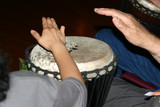Rain Dancing
With a heat wave blazing across the U.S. this summer, rain seems to be on the minds of people across the country. Temperatures are at an all-time high, and many states are seeing drastically low water levels, dried-out crops and gardens and little relief in sight. Droughts and heat waves are nothing new to endure, but, in today’s modern times, the “sit and wait” philosophy seems to be winning out over time-honored practices of indigenous people of the land. In times past, during droughts and periods of excessive heat, these tribes took matters into their own hands and asked their higher powers to provide rain… though dance.
Rain dances are ceremonies that are part of native cultures in the Americas, Africa, Asia and beyond. These group dances are not only a part of the seasonal reverence given to local spiritual beings and powers, but are also exercises in the power of group intention. American Indian rain dances unite both men and women together, recognizing the gifts given to the tribes, as well as summoning rain to help maintain a bountiful harvest. In Africa, rain dances like the Fuba or Kilumi serve a similar purpose, bringing an end to the “dry season” that is typical in many areas of that continent, while welcoming the “rainy season” that supplies water to crops, animals and people for the entire year. Similar to American Indians, South Asian Indians also performed rain dances, and even include a “frog wedding” tradition to help bring rain to nourish crops and the people of the area.
For those living in the modern era, rain dances are still beneficial activities, even for those without tribal ties to the lands and cultures that rely on such ceremonies. While keeping the spirit of native rain dances in mind, creating a community ritual within non-tribal areas is still a possibility to help encourage the rain to fall. Much like American Indian, African and Asian cultures, combining dance with drumming and the intention of giving thanks to the Earth for its gifts can bring about significant changes, at least within the circle of people participating in this rain dance. Researching local customs, or those inherited through ancestral ties, can make a rain dance even more personal and rewarding, and can potentially stimulate the rain to fall. Through the beat of a Djembe drum or the shake of a shekere, amazing things are possible.
Recent Posts
-
X8 Drums Play-Along Backing Tracks
The new X8 Play-Along Series is being produced for our musician friends wanting a fresh way to work …9th Feb 2025 -
What is the Best Size Djembe for Beginners?
If you're new to the world of percussion and interested in learning the djembe, you're in for a t …16th Jul 2024 -
The Benefits of Becoming a Drumming Teacher: Transforming Passion into Profession
Why become a drumming teacher? Becoming a drumming teacher is an excellent way to share your pas …22nd May 2024



